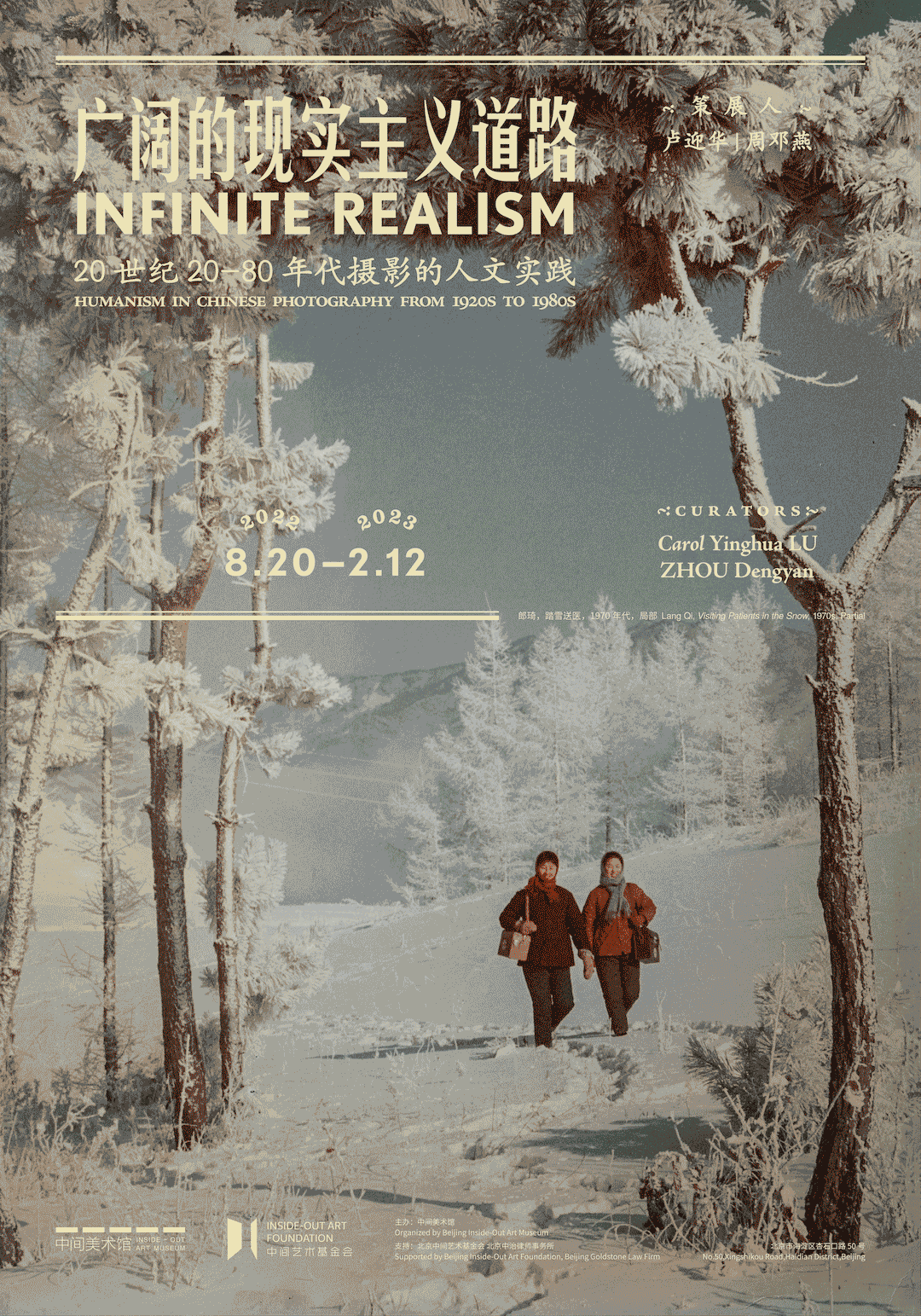
Infinite Realism: Humanism in Chinese Photography from 1920s to 1980s
Aug 20, 2022—Feb 12, 2023
Curators: Carol Yinghua Lu,Zhou Dengyan
Beijing Inside-Out Art Museum, No.50, Xingshikou Road, Haidian District, Beijing
“Infinite Realism: Humanism in Chinese Photography from 1920s to 1980s” showcases the emergence of diverse forms of realism in Chinese photography. The works in this exhibition break the formal rule that realism must appear “realistic.” They transcend the modernist dichotomy between art and reality and refute a simple equation between realism and reality.
When photography was introduced to China in the mid-1800s, it was mainly used for visual documentation and as a tool for portrait drawing. It was not until the 1920s that the artists expanded the medium’s capacity. With the rise of communism in the early 1900s, proletarian revolutionary literature and art caused a rift in the Chinese art world. Creatives grappled with grounding their work in reality and the experiences of ordinary people. In the context of political and cultural upheaval, photography rose to prominence as a medium both grounded in reality and with the capacity to transmit humanist ideology.
On the one hand, photographers can use the documentary aspect of the camera to record social reality. Through their interaction with the world, photographers were uniquely positioned to intervene in and alter reality. On the other hand, the first-person camera-eye perspective of a lens can express the subjectivity and thoughts of the artist operating it. Artists explored the artistic, formal qualities of photography separate from political meaning. This interest in “art for art’s sake” rose from the liberal value of individualism was another facet of the humanistic practice of photography.
After World War I, artists in Europe and North America returned to realism to express their state of mind, halting the avant-garde experimentation of the decade prior. Socialist realism was introduced in China in the 1930s as other types of realism were accused of being subjective, and therefore bourgeois. Since then, realism has been a critical concept and method in Chinese literary and artistic practice. After the 1940s, socialist realism was instrumentalized to promote nationalist dogma. The rigid socialist realism that dominated artistic production constrained the development of diverse realist methods. In the process of its policing, realism became ideological, causing many creators to reject the term. As socialist realism became chained to ideological principles, artists and literati challenged these limitations and debated the definition of realism. Because of its close relationship with ideology, however, it was politically complicated to interrogate how the constraints of realism generated dogmatic, formulaic works of literature and art.
The drive to free artists from narrowly defined realism was international. In 1956, Qin Zhaoyang wrote in “Realism – The Broad Road,” “I think the shackles of dogmatism on literature and art are not only in China but global. It is because this situation is worldwide, that it is perhaps more difficult to overcome.” In 1963, the French literary critic Roger Garaudy published the book On Realism Without Borders. Therein, Garaudy advocated for opening up the definition of realism. Realism, Garaudy argued, should include contemporary, somewhat abstract and fictive works, such as those by Pablo Picasso and Franz Kafka, to “integrate all these new contributions with the legacy of the past.” French author Louis Aragon agreed, noting that “the fate of realism […] depends on the valuation of new facts.” In contrast to a predefined, dogmatic realism, Aragon defended realism as a philosophy and creative approach that confronts an ever-changing reality. Because the nature of reality and fact are constantly changing, confining realism to a predefined form castrates the medium’s generative, futuristic potential.
The photographs in this exhibition explore realism not merely as documentation of “reality,” but rather as authenticity. These photographs express something true about life, ideological structures, and human experience. The works express photographers’ individual, penetrative gazes on reality, as well as their multi-layered photographic interpretations. By understanding realism as something “true to life” rather than something rendered accurately, the exhibition proposes a radically expansive notion of reality beyond socialist realism.
An Ge, Ao Enhong, Bai Tao, Bao Kun, Bei Dao, Bi Jianfeng, Chen Baosheng, Chen Bo, Chen Fuli, Chen Shuxia, Da Hai, Dai Zenghe, Dang Quanli, Deng Wei, Du Zhizhong, Fan Huichen, Fang Dazeng, Gu Cheng, Gu Zheng, Guo Song, Hei Ming, Hong Hao, Hou Dengke, Hu Wugong, Huang Cheng, Huang Daoming, Huang Lin, Huang Xiang, Huang Yongyu, Jia Chaozheng, Jiang Bingnan, Jiang Guoliang, Jiao Jingquan, Jin Bohong, Jin Shisheng, Lang Qi, Li Feng, Li Guohua, Li Jilu, Li Ming, Li Shaotong, Li Shengli, Li Tian, Li Xiaobin, Jia Tiansheng, Liang Zude, Ling Fei, Liu Bannong, Liu Feng, Liu Guangcheng, Liu Jie, Liu Qinghe, Liu Xucang, Lu Shifu, Lv Xiaozhong, Luo Bonian, Ma Mingjun, Ma Yuhuan, Mao Zhanping, Meng Zhaorui, Pan Ke, Peng Kuang, Qi Guanshan, Qian Qun, Ren Shulin, Sha Fei, Shao Du, Shao Jiaye, Shi Baoxiu, Shi Shaohua, Shi Zhimin, Song Shijing, Sun Zhenjie, Shen Xun, Wang Hu, Wang Jinfu, Wang Junhua, Wang Miao, Wang Ping, Wang Ruihua, Wang Xiang, Wang Xiebai, Wang Yan, Wang Yin, Wang Youshen, Wang Yuejin, Wang Zhiwen, Wang Zhiting, Wang Zhiping, Wei Dezhong, Wei Shouzhong, Wen Danqing, Wu Wenhao, Wu Yinbo, Wu Yinxian, Wu Zhongxing, Wu Zuzheng, Xia Yonglie, Xu Xiaobing, Xu Yingzhe, Xu Youhui, Xu Qi, Xu Zhuo, Xue Zijiang, Yang Qun, Ye Liuru, You Yungu, Yu Bangyan, Yuan Shande, Yuan Yiping, Zhai Chunlai, Zhang Aiping, Zhang Baoan, Zhang Jingli, Zhang Li, Zhang Yinquan, Zhang Yunlei, Zhao Jiexuan, Zheng Jingkang, Zheng Jun, Zhou Chunyan, Zhou Wannian, Zhu Lihe, Zhu Tianmin, Zhu Weiping, Zhuang Xueben
Installation views
View the Exhibition Online
Exhibition Brochure
An electronic version of the exhibition brochure is available for viewing. Click here to download









